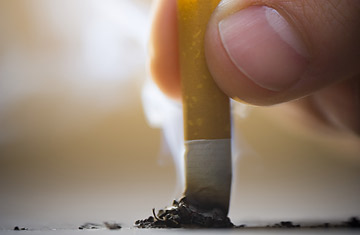
If there's one thing a smoker needs in order to quit, it's moral support — mostly from friends and family subjected to the short temper and irritability that usually accompany one of mankind's most daunting tests of willpower. In 1977, the American Cancer Society offered smokers even more support, launching the Great American Smokeout on the third Thursday in November. On this day every year, smokers across the country try to do what feels impossible — give up their cigarettes for 24 hours. The idea is that many will quit puffing away altogether. (In this spirit, this year's campaign includes an aptly named initiative for next week called "Stay Quit Monday.")
The idea of quitting collectively came 12 years after the landmark U.S. Surgeon General's report connecting tobacco use to lung cancer, low birth weight and coronary disease. Lynn Smith, a newspaper editor in Monticello, Minn., and a former smoker, wrote editorials in the 1970s urging others to quit. Smith, who once told the New York Times he started smoking "as a teenager by picking up butts from the street during the Depression," organized a local event called "D-Day," or "Don't Smoke Day," in 1976. The next year, the California chapter of the American Cancer Society sponsored a similar event, and by 1977, the Great American Smokeout was born. In subsequent years, the Smokeout has encouraged millions of Americans to set aside their packs and cartons, if only for one brief, breathable day. (See pictures of vintage cigarette advertisements.)
By its fourth year, the American Cancer Society claims, as many as 16.5 million people participated in the Smokeout, with a million dropping the habit for good. The campaign was directed in particular at young people; antismoking activists said it was harder to keep teenagers from picking up the habit than to get older people to drop it. According to the National Institute on Drug Abuse, in 1980 21% of high school students were habitual puffers. Over the years, the Cancer Society has enlisted celebrities and health officials to promote the Smokeout campaign — everyone from Dallas star and ex-smoker Larry Hagman (1981) to Mr. Potato Head, who was 1987's "Spokespud." (Some reports at the time said he turned over his plastic pipe to the Surgeon General in the process.) Throughout the Smokeout's history, other gimmicks have been employed, including free giveaways (apples or ice cream scoops in exchange for packs of cigarettes), friendly intimidation (volunteers dressed as smoke detectors blowing kazoos at smokers on the street) and slogans ("Kiss me, I don't smoke").
The smoking rate among Americans has fallen steadily since the 1964 Surgeon General's report, from 42% that year to 19.8% of adults in 2007, according to the Centers for Disease Control and Prevention. Smokeout organizers claim some responsibility, saying the campaign "set the stage for the cultural revolution in tobacco control that has occurred over this period." For younger generations of Americans, it's hard to imagine that as recently as the 1980s, smoking was allowed on commercial airplanes and in hospitals. The Smokeout has helped, to be sure, but so too have restrictions on tobacco advertising, local bans and, notably, the Tobacco Master Settlement, which ordered cigarette makers to pay some $200 billion to states to cover smoking-related health costs and public education efforts. The 10-year anniversary of the settlement is this month.
